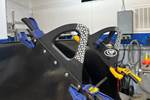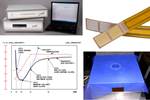CRP Windform composites show high affinity for electric insulation
GFRTP materials for 3D printing were subjected to dielectric constant and dielectric strength tests, indicating strength for use in electric applications like automotive.
A motor developed using CRP Windform materials. Source | CRP Technology
3D printing service bureau CRP Technology (Modena, Italy) announces that its glass fiber-reinforced thermoplastic (GFRTP) composite Windform materials, designed for the selective laser sintering (SLS) process, have demonstrated positive electrical insulation performance as confirmed by recent dielectric constant and dielectric strength tests. These tests have revealed excellent results, the company notes, exhibiting a dielectric constant of approximately 4 and withstanding peak voltages of at least 2.5 kilovolts/millimeter (kV/mm).
Identified by their specific mechanical and thermal properties, Windform composites have undergone rigorous dielectric constant and dielectric strength tests, essential for evaluating material performance for applications requiring electrical insulation. In today’s automotive industry, characterized by hybrid or fully electric vehicles, the use of insulating materials is increasingly becoming paramount.
The dielectric constant is a fundamental constant in physics that represents a material’s ability to resist the formation of an electric field within it. During testing, CRP’s GFRTP materials — Windform LX 3.0, Windform GT and Windform FR2 — exhibited a dielectric constant close to 4, with Windform LX 3.0 and FR2 slightly above 4, and Windform GT slightly below. The tests were conducted at the standard frequency of 1 kilohertz.
The dielectric strength test evaluated the maximum electric potential difference the materials can withstand before conducting electricity. Windform LX 3.0, Windform GT and Windform FR2 demonstrated high performance, enduring peak voltages of at least 2.5 kV/mm without any signs of deterioration. Specimens with a thickness of approximately 1.6 millimeters were subjected to sinusoidal voltages alternating at 50 hertz and amplitudes up to 4,000 volts without discharge.
According to the company, these results are significant for electrical applications, where maintaining a dielectric constant around 4 is crucial, especially in fully electric vehicles with high voltage. Moreover, the ability for GFRTP Windform materials to withstand voltages of at least 2.5 kV/mm ensures reliability and safety. Application examples include battery housings, power converter housings, cooling and air conditioning system components, and charging connector housings.
Related Content
-
Thermoplastic composites: Cracking the horizontal body panel nut
Versatile sandwich panel technology solves decades-long exterior automotive challenge.
-
Infinite Composites: Type V tanks for space, hydrogen, automotive and more
After a decade of proving its linerless, weight-saving composite tanks with NASA and more than 30 aerospace companies, this CryoSphere pioneer is scaling for growth in commercial space and sustainable transportation on Earth.
-
Carbon fiber, bionic design achieve peak performance in race-ready production vehicle
Porsche worked with Action Composites to design and manufacture an innovative carbon fiber safety cage option to lightweight one of its series race vehicles, built in a one-shot compression molding process.






